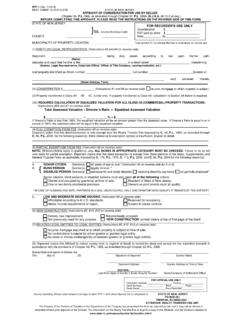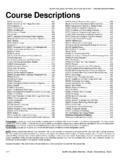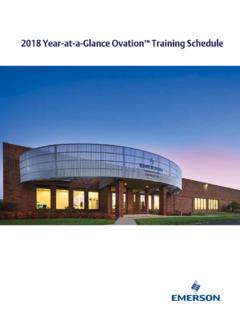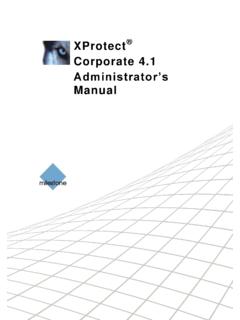Transcription of Stop Motion Handbook
1 CRAIG LAURIDSEN. Stop Motion Handbook . using GarageBand and iStopMotion Teacher lesson plans This book contains comprehensive information about a wide range of topics relating to making stop Motion movies. When used in a classroom, teachers can easily derive lesson plans for curriculum activities. The following pages outline some possible lesson plans. 1 Write a 3-act story which develops a premise 2 Write a story into a script 3 Write the script for a 30 second TV advertisement 4 Create a plasticine character 5 Create a scene set in scale 6 Record a soundtrack in GarageBand 7 Record stop Motion pictures in iStopMotion 8 Animate a Lego character to walk 9 Animate a character to talk 10 Dramatise an action sequence 11 Develop an interactive whiteboard illustration 12 Time lapse 13 Add a title and credits in iMovie Most lessons can be undertaken in groups of up to three students.
2 Each lesson plan contains: A list of required prerequisites, equipment and resources Time allowance. Increasing the time will allow students to focus on quality improvement References to relevant pages in this book Suggested areas for assessment. 1. Stop Motion Handbook Lesson Plan Write a 3-act story which develops a premise Learning area: English narrative development Requires paper, pen and a copy of table on page 23*. Allow 60 minutes. Lesson plan reference Page 18; Whole group discussion on the importance of a story Page 19, step 1; Working individually, or in groups of up to three, write a premise Page 21, step 2; Brainstorm questions which develop the premise Page 22; Write the story in three acts. Hand out copies of the story outline table on page 23*. Students need to write at least one sentence for each of the seven prompts. Key things to assess Originality of premise At least one sentence for each of the seven prompts in the story outline Logical idea development.
3 *You can download an A4 copy of the story outline at 2. Stop Motion Handbook Lesson Plan Write a story into a script Learning area: English narrative development Requires completed story outline from Lesson 1, paper and pen. Allow 60 minutes for a one minute movie. Adjust for longer movies. Lesson plan reference Page 22, step 4; Take the 3-act story outline developed in Lesson 1. and write the story into a script. Students need to determine the characters, locations, actions and lines of dialogue to support dramatising the story Guide students on script parameters, for example: - include at least three characters with speaking lines - no more than 2 locations (this will simplify artwork requirements). - movie duration (this will determine the length of the script. A one minute movie should have 8-16 lines and fill about half a page. A five minute movie could fill 2-3 typed pages).
4 Page 22, step 5; Add scene descriptions and labels (this is an optional step for formatting longer scripts). Key things to assess Accuracy of interpretation of story outline from lesson 1. Character development Meets stated script parameters. 3. Stop Motion Handbook Lesson Plan Write the script for a 30 second TV advertisement Learning areas: English, Arts, Social Science This is an alternative exercise to develop a script. It requires writing that is both clear and brief. Requires paper and pen. Allow 60 minutes. Full completion of the stop Motion advertisement (Lessons 3 to 7) could be achieved in around 4 hours (thirty seconds of stop Motion using 12 pictures per second is only 360 pictures). Titles and credits, if any, can be added to the end of the batch, not after each advert. Lesson plan reference Group discussion on TV advertising Page 28, steps 1 to 4; Guide students on product or service parameters, such as: - something to promote healthier lifestyle - something to make you richer/save money.
5 The goal of most advertising is to convince someone of their need to buy a product or service. It can be a fun and challenging task to advertise something that no one wants, such as cobwebs, cat pee, dirty socks, traffic jams, teachers. For presentation, use iMovie to edit together all class advertisements into a commercial break' as they would appear on TV. Key things to assess Suitability of product or service for stated guideline Persuasiveness of proposed benefits Realistic and practical artwork requirements Script can be read in less than 30 seconds. 4. Stop Motion Handbook Lesson Plan Create a plasticine character Learning area: Arts Requires art working space, wire, plasticine, beads, modelling tools (see pages 64-65). Students may need supervision with use of bonding agent for armature. Allow 60 minutes. Lesson plan reference Page 65; Make an armature for a character and then mold it with Plasticine.
6 The character should be able to stand balanced and have some limb movement (see also examples and tips on pages 66-68). Key things to assess Solid construction and ability for some limb movement Ability of character to stand balanced Good use of colour, detail and overall presentation. 5. Stop Motion Handbook Lesson Plan Create a scene set in scale Learning areas: Arts, Maths Requires art working space, art materials and access to camera, tripod and stage. Younger students may require supervision with scissors for cutting cardboard. This exercise assumes that characters (Lego, Plasticine or other) for the stop Motion movie have been created. Allow 60 minutes. Lesson plan reference Pages 70; Temporarily set up stage and camera. Look through camera and mark the maximum height, projected character head height and horizon area on background Pages 71-76; Create the artwork for background and props in the same scale as the character.
7 Key things to assess Appropriate size and proportion of background detail when viewed through camera Appropriate scale between characters, props and background Good use of colour, detail and overall presentation. 6. Stop Motion Handbook Lesson Plan Record the soundtrack in GarageBand Learning areas: Computer skills, Arts, Music This activity can be achieved with students in the group taking turns to record the voices of each other, or with a helper to operate GarageBand, so all students in group can focus on their voice role. Requires a recording space (see pages 58-60), microphone and computer with GarageBand (see pages 32-34). Students with musical ability could use USB keyboard or guitar. Advanced students can be assessed to set up recording location with the criteria on pages 58-60. Allow 1-2 hours to complete 1 minute soundtrack. Adjust for longer soundtracks, those which make significant use of sound effects or require music composition.
8 Lesson plan reference Group discussion on general topic of music copyright and specific guidelines for use of music in soundtrack (see page 30). Page 32; Group discussion on questions at top of page Page 38-40, steps 1 to 6; with reference, as required, to pages 35-60. Key things to assess Clarity of speech Appropriate tone and passion of voices Appropriate selection of music and sound effects No use of music without copyright clearance Minimal unwanted and background noises. 7. Stop Motion Handbook Lesson Plan Record stop Motion pictures in iStopMotion Learning areas: Computer skills, Arts Recording stop Motion pictures is best done with longer sessions because of the set up time required. If you have an area that can be left set up, students can make progress with a series of shorter sessions. Requires: - soundtrack from Lesson 6, or other source - a room with tables where lighting can be controlled - stop Motion stage set, characters, backgrounds, props, camera, tripod and computer with iStopMotion.
9 See pages 85-91 for set up of camera and lighting. Hands-on experience of simple animation effects is a valuable learning exercise before completing the first movie. Allow 1-2 hours per 30 seconds of movie, plus set up time. Lesson plan reference Page 95; Pre-recording checklist Page 98-105, steps 1 to 9; Making a stop Motion movie. See also pages 77-84 (picture composition), 96-97 (using iStopMotion), 116-121 (creating actions), 128-130 (avoiding common mistakes). Key things to assess Image composition. Good use of manual focus Good camera movements to dramatise the story and follow the character who is talking. Steady camera at all other times Appropriate character movements Consistent lighting Minimal common mistakes (see pages 128-130). Logical file naming system (see page 15). Stop Motion Handbook Lesson Plan 8 Animate a Lego character to walk Learning areas: Computer skills, Arts Making a character walk is a fundamental skill for using Lego in stop Motion .
10 It can be adapted for other character mediums. This skill can be incorporated into an actual movie, or as a list of prescribed activities: walking, running, dancing, moon walking, dodging bullets Matrix' style, turning around and slow walk, or whole body expressions, such as showing surprise. Requires stop Motion stage set, characters, camera, tripod and computer with iStopMotion. Allow 60 minutes. Lesson plan reference Pages 110-111;. See also pages 108-109 to use a video recording as a reference for movements. Key things to assess Realism of movement Hand and head movements Integration with props, eg picking something up. 9. Stop Motion Handbook Lesson Plan Animate a character to talk Learning areas: Computer skills, Arts, English Can be used to dramatise a poem or text extract, instead of a story. Requires stop Motion stage set, characters, camera, tripod and computer with iStopMotion.





